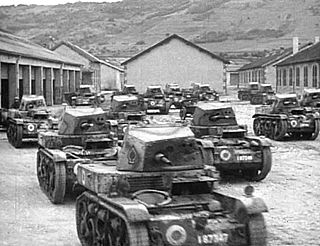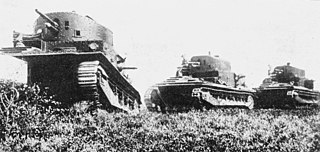
A tank destroyer, tank hunter, or tank killer is a type of armoured fighting vehicle, armed with a direct-fire artillery gun or missile launcher, designed specifically to engage and destroy enemy tanks, often with limited operational capacities.

The Panzer II is the common name used for a family of German tanks used in World War II. The official German designation was Panzerkampfwagen II.

The Jagdpanzer 38 was a German light tank destroyer of the Second World War based on a modified Czechoslovakian Panzer 38(t) chassis.

The Jagdtiger is a German casemate-type heavy tank destroyer from World War II. It was built upon the slightly lengthened chassis of a Tiger II. Its ordnance inventory designation was Sd.Kfz. 186.

Sturmtiger was a World War II German assault gun built on the Tiger I chassis and armed with a 380mm rocket-propelled mortar. The official German designation was Sturmmörserwagen 606/4 mit 38 cm RW 61. Its primary task was to provide heavy fire support for infantry units fighting in urban areas. The few vehicles produced fought in the Warsaw Uprising, the Battle of the Bulge and the Battle of the Reichswald. The fighting vehicle is also known by various informal names, among which the Sturmtiger became the most popular.

The Sturmgeschütz III assault gun was Germany's most-produced fully tracked armoured fighting vehicle during World War II, and second-most produced German armored combat vehicle of any type after the Sd.Kfz. 251 half-track. It was built on a slightly modified Panzer III chassis, replacing the turret with an armored, fixed superstructure mounting a more powerful gun. Initially intended as a mobile assault gun for direct-fire support for infantry, the StuG III was continually modified, and much like the later Jagdpanzer vehicles, was employed as a tank destroyer.

The Jagdpanther, Sd.Kfz. 173, was a tank destroyer built by Germany during World War II based on the chassis of the Panther tank. It entered service in 1944 during the later stages of the war on the Eastern and Western Fronts. The Jagdpanther combined the 8.8 cm Pak 43 cannon, similar to the main gun of the Tiger II, and the armor and suspension of the Panther chassis. During the last stages of the war, limited German production resulted in small production numbers, shortage of spare parts, and shortened crew training periods of younger operators.

The Sturmpanzer was a German armoured infantry support gun based on the Panzer IV chassis used in the Second World War. It was used at the Battles of Kursk, Anzio, Normandy, and was deployed in the Warsaw Uprising. It was known by the nickname Brummbär by Allied intelligence, a name which was not used by the Germans. German soldiers nicknamed it the "Stupa", a contraction of the term Sturmpanzer. Just over 300 vehicles were built and they were assigned to four independent battalions.

The Sturmgeschütz IV , was a German assault gun variant of the Panzer IV used in the latter part of the Second World War. It was identical in role and concept to the highly successful StuG III assault gun variant of the Panzer III. Both StuG models were given an exclusively tank destroyer role in German formations and tactical planning in the last two years of the war, greatly augmenting the capability of the dwindling tank force available to the German army on the Eastern and Western fronts.

The Jagdpanzer IV, Sd.Kfz. 162, was a German tank destroyer based on the Panzer IV chassis and built in three main variants. As one of the casemate-style turretless Jagdpanzer designs, it was developed against the wishes of Heinz Guderian, the inspector general of the Panzertruppen, as a replacement for the Sturmgeschütz III. Guderian objected against the needless, in his eyes, diversion of resources from Panzer IV tank production, as the Sturmgeschütz III was still more than adequate for its role.

The Automitrailleuse de Reconnaissance Renault Modèle 35 Type ZT was a French light tank developed during the Interbellum and used in the Second World War. It was not intended to reconnoitre and report as its name suggests but was a light armoured combat vehicle, mostly without a radio and used as a support tank for the mechanised infantry.

The Medium Mark B was a British tank of the First World War developed as a successor to the Whippet, but ultimately unsatisfactory and production was cancelled at the end of the war.

The Mark IX tank was a British armoured fighting vehicle from the First World War. It was the world's first specialised armoured personnel carrier (APC).

The Mark VIII tank also known as the Liberty or The International was a British-American tank design of the First World War intended to overcome the limitations of the earlier British designs and be a collaborative effort to equip France, the UK and the US with a single heavy tank design.

The Vickers Medium Mark I was a British tank of the Inter-war period built by Vickers from 1924.

The Type 5 medium tank Chi-Ri was a medium tank developed by the Imperial Japanese Army in World War II. Intended to be a heavier, more powerful version of Japan's prototype Type 4 Chi-To medium tank, in performance it was designed to surpass the US M4 Sherman medium tanks being fielded by the Allied forces. A single prototype was incomplete when the war ended.

The Uralmash-1 (Уралмаш-1) was a Soviet prototype self-propelled gun developed during World War II. It was a turretless, tracked armoured fighting vehicle designed by the Yekaterinburg-based Uralmash design bureau (UZTM) between autumn 1944 and spring 1945. It used the chassis of the T-44 medium tank and was intended to replace the SU-100 which itself had only entered service with the Red Army in late 1944. Two prototypes of the Uralmash-1 with different armament were built in early 1945, one with the 100 mm D-10 tank gun, the other with the 122 mm D-25S tank gun. While mass production was initially recommended, the end of the war with Germany in May 1945 eventually caused the project to be cancelled due to lack of necessity. If the Uralmash-1 had entered service, the 100 mm variant would have been designated SU-101 (СУ-101) while the 122 mm variant would have been designated SU-102 (СУ-102), in accordance with Soviet military nomenclature, where the "SU"-label stood for Samokhodnaya Ustanovka, or self-propelled gun.

The KSP-76 was a Soviet wheeled assault gun that began development in 1943. It mounted a 76 mm divisional gun M1942 (ZiS-3) gun on a lightweight chassis in an attempt to provide support for scout and airborne units. The light chassis proved unable to withstand repeated firings of the gun and the project never got beyond the prototype stage.

FV 4401 Contentious was a prototype British air-portable tank destroyer of the early 1960s. At least one prototype was constructed and tested, although no production vehicles were built or saw service.
The Panzerkampfwagen II (Pz.Kpfw.II) light tank, produced in Germany in the late 1930s and early 1940s had a wide array of variants, both as development of the light tank and for specialised tasks.




















